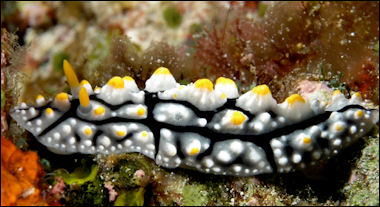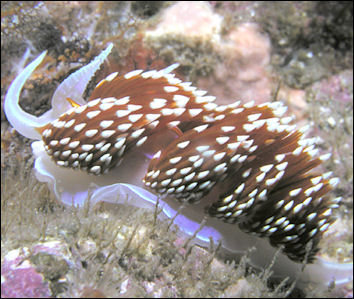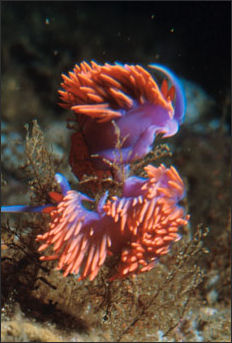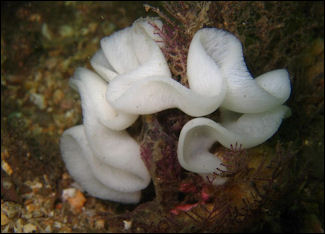Home | Category: Coral Reef Life / Sea Slugs, Nudibranchs, Star Fish and Unusual Sea Life
NUDIBRANCHS
.jpg)
Chromodoris magnifica Nudibranchs, kinds of sea slugs, are among the world’s more colorful creatures, with species boasting bright yellow, pink and orange features and patterns. Most are finger-sized with gills-forming tufts on their backs (Nudibranch means “naked gill,” a feature that separates them from other kinds of sea slugs). They don’t have any shell — or skeleton — so when they perish after living for about a year they leave behind no evidence of their existence. [Source: David Doubilet, National Geographic, June 2008]
Nudibranchs are found in the benthic (sea floor) zone of tropical and temperate regions of the ocean. Jennifer Holland wrote in National Geographic, “Nudibranchs crawl through life as sick and naked as newborn. Snail kin whose ancestors shrugged off their shell millions of years ago, they are just skin, muscle and muscles and organs sliding on trails of slime across ocean floors and coral heads the world over...Found from sandy shallows and reefs to the murky seabed nearly a mile down, nudicranchs thrive in water both warm and cold and even around billowing deep-sea vents.”
There are more than known 3,000 species of nudibranch (many scientists believe only about half of all nudibranch species have been found). They feed on coral, sponges, barnacles, eggs, small fish and one another. Some feed only on a single species such as sea pen. Some have teeth and jaws. Others rely on enzymes to break down prey.
Nudibranchs do not often appear in museum collections because there is no known technique to preserving the shape, size, or color of a non-living specimen. Because color morphology is so distinct in nudibranchs, good color photographs are useful in identifying them, and nice to look at anyway. [Source: Megan Jones, Animal Diversity Web (ADW)]
Related Articles: ECHINODERMS (SEA STARS, SEA CUCUMBERS AND SEA URCHINS): CHARACTERISTICS, BEHAVIOR, REPRODUCTION ioa.factsanddetails.com ; SEA CUCUMBERS: CHARACTERISTICS, BEHAVIOR AND PRODUCTS ioa.factsanddetails.com ; SEA CUCUMBER SPECIES: BIG, COLORFUL, TOXIC, UGLY AND EDIBLE ONES ioa.factsanddetails.com ; SEA SLUGS: STRANGE, VIOLENT SEX, HEADS THAT REGROW BODIES AND SEA HARE ORGIES ioa.factsanddetails.com ; SOLAR-POWERED SEA SLUGS — ANIMALS THAT PHOTOSYNTHESIZE ioa.factsanddetails.com ; SPECIES AND TYPES OF NUDIBRANCHS: BEAUTIFUL, STRANGE AND TOXIC ONES ioa.factsanddetails.com ; CORAL REEFS ioa.factsanddetails.com ; CORAL REEF LIFE ioa.factsanddetails.com REEF FISH ioa.factsanddetails.com
Websites and Resources: Animal Diversity Web (ADW) animaldiversity.org; National Oceanic and Atmospheric Administration (NOAA) noaa.gov; Fishbase fishbase.se; Encyclopedia of Life eol.org; Smithsonian Oceans Portal ocean.si.edu/ocean-life-ecosystems ; Monterey Bay Aquarium montereybayaquarium.org ; MarineBio marinebio.org/oceans/creatures; Websites and Resources on Coral Reefs: Coral Reef Information System (NOAA) coris.noaa.gov ; International Coral Reef Initiative icriforum.org ; Coral Reef Alliance coral.org ; Global Coral reef Alliance globalcoral.org ; Global Coral Reef Monitoring Network gcrmn.net
Nudibranchs Versus Sea Slugs
Sometimes the terms “nudibranch” and “sea slugs” are used interchangeably but that is not necessarily correct. Nudibranchs are a subset of sea slugs. While all nudibranchs are sea slugs, not all sea slugs are nudibranchs. “Sea slug” does not represent a specific taxonomic group but refer to different clades ( groups of organisms believed to be evolutionary descendants of a common ancestors).in the class of Gastropoda (snails and slugs including those in freshwater and on land). [Source: Wikipedia]

Nudibranch off Komodo A Sea slug is a shell-less marine mollusc which is typically brightly coloured, with external gills and a number of appendages on the upper surface.. Sea slugs are gastropods — sea snails (marine gastropod mollusks) that over evolutionary time have either completely lost their shells, or have seemingly lost their shells due to having a greatly reduced or internal shell. The name "sea slug" is applied to nudibranchs, as well as to a paraphyletic set of other marine gastropods without obvious shells
Nudibranchs are shell-less marine mollusc of the order or clade Nudibranchia. Nudibranch means “naked gill,” a feature that separates them from other kinds of sea slugs. Most nudibranchs are not large, they are often very eye-catching with their brilliant colors. A number of other taxa of marine gastropods — many of them "sea slugs" — are easily mistaken for nudibranchs.
Types of Nudibranchs: Dorid and Aeolid
Nudibranchs are commonly divided into two main kinds: 1) dorid and 2) aeolid (also spelled eolid) nudibranchs. Dorids (clade Anthobranchia, Doridacea, or Doridoidea) have having an intact digestive gland and the feather-like branchial (gill) plume, which forms a cluster on the outside part of the body, around the anus. Fringes on the mantle do not contain any intestines. Additionally, dorid nudibranchs commonly have distinct pockets, bumps, and/or mantle dermal formations, which are distortions on their skin, used to store bioactive defense chemicals. [Source: Wikipedia]
Aeolids (clade Cladobranchia) have cerata (anatomical structures on on the backs of these nudibranch) instead of the branchial plume. The cerata (singular cera) serve in place of gills and facilitate gas exchange through the epidermis (skin). Additionally, aeolids possess a branched digestive gland, which may extend into the cerate and often has tips that contain cnidosacs (stinging cells absorbed from prey species and then used by the nudibranch).They lack a mantle. Some are hosts to zooxanthellae.

Thick-horned nudibranch Dorid nudibranchs (Scientific name: Hypselodoris) are members of a genus of colourful sea slugs or, marine gastropod mollusks in the family Chromodorididae. They are pproximately 70 described species, which are commonly divided into two major clades. 1) Eastern Pacific and Atlantic and 2) Indo-Pacific. It is thought that these two groups were separated by the Pacific Ocean and the division predates the formation of the Panama isthmus, which is why the Eastern Pacific and Atlantic species are group together. One thing that distinguishes the two groups are color. The Indo-Pacific species vary more in their coloration and have more compact sperm storage structures. The eastern Pacific and Atlantic clade often have a dark blue base color and a variety of spot and stripe patterns. They are found in both the Pacific and Atlantic coasts of North and South America, and in the Atlantic coasts of Europe and Africa. Morphologically, they have larger sperm storage structures than those in the Indo-Pacific Dorid Nudibranchs Synonyms: Brachychlanis, Brachyclanis, Jeanrisbecia, Pterodoris, Risbecia
[Source: Megan Jones, Animal Diversity Web (ADW) /=]
The taxonony of nudibranchs has undergone extensive revision in recent years. They used to be classied as the order Nudibranchia, within the gastropod mollusc subclass Opisthobranchia (tmarine slugs: nudibranchs, sidegill slugs, bubble snails, algae sap-sucking sea slugs, and sea hares). Since 2005, pleurobranchs (which had previously been grouped among sidegill slugs) have been placed alongside nudibranchs in the clade Nudipleura (recognising them as more closely related to each other than to other opisthobranchs). Since 2010, Opisthobranchia has been recognised as not a valid clade (it is paraphyletic) and instead Nudipleura has been placed as the first offshoot of Euthyneura (which is the dominant clade of gastropods).
Nudibranch Characteristics
Nudibranchs are soft-bodied slugs without shells. They also lack the gills and mantle cavity that most other gastropods have. They are cold blooded (ectothermic, use heat from the environment and adapt their behavior to regulate body temperature) and have bilateral symmetry (both sides of the animal are the same). They have: 1) paired oral tentacles or veils; 2) paired rhinopores (club-shaped, rod-shaped or ear-like chemosensory structures which are the most prominent part of the external head anatomy in sea slugs and nudibranch); 3) 13 haploid chromosomes (compared to 23 in humans: and 4) are semelparous (have a single reproductive episode before death). [Source: Megan Jones, Animal Diversity Web (ADW) /=]

thick-horned nudibranch
Most nudibranchs are very colorful and have a variety of patterns. Depending on the species, the color denotes danger (foul Respiration occurs through the epidermis of the dorsal body wall. Many nudibranchs have two sets of tentacles, called anterior sensory organs, on its head. One of the sets of tentacles, called rhinophores, is located on the dorsal side and are used in olfaction and sensing the presence of prey, possible predators, and members of the same species. Oral tentacles taste and feel surrounding. The antenna-like rhinophores act like a nose to detect chemical signals. The eyes can not make out their fantastic colors, discerning little more than light and dark.
Synapomorphies (characteristics found in an ancestral species and shared by their evolutionary descendants) includes: A) Loss of shell; and B) Hermaphroditic reproductive system. Nudibranchs evolved from shelled, torted ancestors. Torted animals have shells. Over time they completely lost all vestiges of shell, and their bodies de-torted. At the anterior end is a pair of tentacles (rhinophores), which are chemo-sensory structures, and near the posterior end are the gills (pseudobranchia). /=\
Nudibranchs have a muscular foot that enables them to crawl across the hard surfaces, They can release their grasp and tumble in the current. Nudibrachs also have flaps or fins on the lateral sides of the foot, called parapodia. These structures allow the animals to swim. Some can even swim freely but most don't do it so often.
Morphologically, dorid nudibranchs have a high body profile and laterally-opening glands along the edge of the mantle. According to Animal Diversity Web: Generally, they have teeth with curved points which include bicuspid lateral teeth, however they lack a rachidian row of radular teeth. This genus has branched vestibular glands, which are primarily used for lubrication of female sex organs. Nudibranchs are also characterized by the presence of receptaculum seminis, or sperm storage structures, that open in the middle of the vaginal duct. The eastern Pacific and Atlantic clade are thought to have larger receptaculum seminis than the Indo-Pacific clade. [Source: Megan Jones, Animal Diversity Web (ADW) /=]
Nudibranch Colors
tasting) or serves an unknown purpose. Typically their is used as a visual signal to warn predators that most nudibranchs are toxic if ingested. Many nudibranchs announce they carry toxins with garish colors that contrast markedly against the green and brown rocks and reef they crawl over. Chromodoris quadricolor are believed to use their striking colors to alert potential predators of their nasty chemical taste.
East Pacific and Atlantic dorid nudibranchs tend to be blue with spots or stripes of numerous colors, excluding red. Species in the Indo-Pacific clade are more varied in their coloration — they range from pink/purple to orange/yellow, and also have a wide variety of spot and stripe patterns. Scientists study dorid nudibranchs to gain insight into the effects of geographical separation on the evolution of color patterns. [Source: Megan Jones, Animal Diversity Web (ADW) /=]
Several species of dorid nudibranchs are considered Müllerian mimics, meaning that they share similar coloration with another species, but each species is equipped with its own chemical defense mechanism. Creatures that mimic the nudibranch's vibrant colors, including non-toxic nudibranchs, are often also left alone by potential prdators. Some species, especially those that are most active at night and limit themselves to a small range, deploy camouflage rather than warning signs.
Nudibranch Toxins
.jpg)
black spotted nudibranch Nudibranchs, wrote Holland “are well equipped to take care of themselves. Not only can they be tough-skinned, bumpy and abrasive, but they’ve also traded the familiar shell for less burdensome weaponry: toxic secretions and stinging cells. A few make their own poisons, but most pilfer from the foods they eat. Species that dine on toxic sponges, for example, alter and store the irritating compounds in their bodies and secrete them from skin cells or glands when disturbed. Other nudibranchs hoard capsules of tightly coiled stingers, call nematocysts, ingested from corals, anemones and hydroids. Immune to the sting, the slugs deploy the stolen artillery along their own extremities.”
Typically, chemical defenses in nudibranchs are derived from their diet, but can also be produced internally. According to Animal Diversity Web: Defensive allomones are typically located in the mantle and have toxic properties that deter other animals from feeding on nudibranchs. However, some species do not have chemical deterrents and some are considered to be Bayesian mimics of other species. [Source: Megan Jones, Animal Diversity Web (ADW)]
Some species of sea slug and nudibanch float in the water and consume jellyfish. When they eat jellyfish they take the stinging cells into their gut unmolested. The toxin eventually migrates through the seas slug's tissue into its back and provided protection against predators. Glaucus atlanticus, which is camouflaged in blue and silver, prey on toxic Portuguese men-of-war, appropriating their stinging cells of its own defense in their finger-like cerata. Other species like the Pyjama slug Chromodoris quadricolor may use their striking colors to alert potential predators of their nasty chemical taste.
Some species of fish, sea spider, turtle, sea star and crab can eat toxic nudibranchs and suffer no ill effects, Some people eat them too after removing their toxic parts. Chileans and islanders off of Russia and Alaska roast or boil sea slugs or eat them raw. Photographer David Doubilet compared the experience to “chewing on an eraser.”
Nudibranch Behavior, Movement, Senses and Communication
Nudibranch are motile (move around as opposed to being stationary), sedentary (remain in the same area) and generally solitary with aggregate behaviors sometimes occurring during mating. Nudibranchs usually stay close to environments that meet their dietary requirements. [Source: Megan Jones, Animal Diversity Web (ADW) /=]

Mating Nudibranchs According to Animal Diversity Web: Because they occupy the benthic zone, they rarely swim, although they are able to. Swimming is not advantageous because they may encounter predators, and because ocean currents may carry them away from their preferred habitat. Nudibranch are more often seen crawling across benthic substrates. Motionless floating behaviors are observed in some nudibranchs, which allows them to remain in the water column without the high energy expenditure of swimming. Floating is also a function of foraging behavior — since individuals cannot swim and feed at the same time, this allows them to open their oral hood to sample the environment for prey or potential mates.
Nudibranch sense using touch and chemicals usually detected with smell and communicate with vision, touch and chemicals usually detected by smelling, mimicry and pheromones (chemicals released into air or water that are detected by and responded to by other animals of the same species), Despite using visual signals to communicate with predators, nudibranch have relatively low visual acuity. Tactile signals are more commonly used for communication with members of their own species, specifically during mating behaviors. Nudibranchs approach other individuals by touching their head, tail, or the sides of the body. They often utilize chemoreception structures, called rhinopores, to obtain information about the location of food and mates. Slugs intraspecifically communicate their location in the form of pheromones, which are thousands times stronger than pheromones found in the human bloodstream /=\
Nudibranch Feeding, Predators and Ecosystem Roles
Nudibranchs are carnivores that prey on sessile (fixed in one place) organisms and are found near food sources such as coral, sponges, or anemones. They tend to be specialized feeders of animals that are not heavily exploited by other taxa — such as sponges, corals, bryozoans, or hydroids. According to Animal Diversity Web: Some species are cannibalistic and will feed on other nudibranchs. Typically, sea slugs practice stenophagy, meaning that different species have a specialized diet of one or two kinds of food. Nudibranchs appear to graze on sessile food items and strike at more formidable prey, such as cnidarians. [Source: Megan Jones, Animal Diversity Web (ADW) /=]

nudibranch egg ribbon Despite their lack of a protective shell, nudibranchs display a wide variety of anti-predatator strategies. Several species use crypsis as a form of predator avoidance, but most sea slugs are known for their striking aposematic coloration. Most nudibranchs rely on chemical defenses that are typically derived from their diet, and have the ability to select food items containing furanosesquiterpenoids, or toxic essential oils. The combination of chemical defenses and aposematic coloration in are why they are rarely predated on, except by other cannibalistic species of sea slugs. [Source: Megan Jones, Animal Diversity Web (ADW) /=] /=\
With formidable anti-predator defense strategies, nudibranchs serves as a predator within the ecosystem more so than prey. Because they are carnivorous and their prey is sessile, nudibranchs approach an ecto-parasitic relationship with animals such as sponges, coral, and hyroids. They graze on these sessile (fixed in one place) organisms, extracting nutrients without causing immediate death.
Nudibranch Reproduction and Development
Nudibranchs are simultaneous hermaphrodites in which individuals have sex organs of both sexes and can produce both sperm and eggs even in the same breeding season. They pair up and lay in coils, ribbons or tangled clumps of eggs, up to 2 million at a time. Two-centimeter-long "Hypselodoris whitei” mate head to tail through a genital aperture. Each fertilizes the other and both produce eggs.
Nudibranchs engage in internal reproduction in which sperm from the male fertilizes the egg within the female. They employ sperm-storing (producing young from sperm that has been stored, allowing it be used for fertilization at some time after mating). Nudibranchs lay egg ribbons that are often attached to rocks or sessile marine organisms. Other than choosing suitable locations for egg masses, nudibranchs are not known to have any parental involvement in the raising of offspring. [Source: Megan Jones, Animal Diversity Web (ADW) /=]
Even though nudibranchs are simultaneous hermaphrodites, but do not often self-fertilize because they have the ability to store sperm. According to Animal Diversity Web: During copulation, a mating pair will align their gonopores (genital pores) to exchange gametes.
Individuals are usually in fixed position side-by-side during copulation, and have been observed both during the day and at night. Copulation is preceded by what is thought to be courtship behavior, which is expressed in a variety of behaviors such as head contact, or contact with the edges of the mantle. Egg dispersal is low, and survival rates of egg clutches is approximately 5-7 percent. Hatchling emerges and float away in the current. /=\
Nudibranch life cycle is characterized by metamorphosis — a process of development in which individuals change in shape or structure as they grow. Larvae are free-living, and thus drift unprotected by either parent. In its early stages of life nudibranchs looks very different from adults. Free-swimming, shelled larva called veligers are released from the egg. Shortly after hatching the shell is lost. While initially planktonic, the veliger eventually settles on the ocean floor where it metamorphoses into a juvenile. Development time can vary with water temperature. [Source: Melanie Kuehl; Joanne Sountis; Christy Young; Craig Zagata, Animal Diversity Web]
Nudibranchs, Humans and Conservation
Humans utilize nudibranchs for enjoyment (by divers and people look at pictures of them), research, education and potential sources of medicines. Several FDA-approved chemical products were originally isolated from mollusks and have been used in drugs and tested in clinical trials. [Source: Megan Jones, Animal Diversity Web (ADW) /=]
Nudibranchs are of interest to scientists because of the chemical properties of their toxic oils. Hypselodoris jacksoni is first known natural source of the metabolite (−)-(5R,6Z)-dendrolasin-5-acetate. There is a lot unexplored chemical synthesis research in regard to nudibranchs, which has many applications in education and medicine.
There are no listings of the conservation status of nudibranch groups, nor any of their species. They have not been evaluated for the International Union for Conservation of Nature (IUCN) Red List: Research has suggested that total nudibranch abundance along the coast of California is highly correlated with warming. This relationship suggests the potential use of nudibranchs as an indicator taxa of climate change.
Image Sources: Wikimedia Commons, NOAA
Text Sources: Animal Diversity Web (ADW) animaldiversity.org; National Oceanic and Atmospheric Administration (NOAA) noaa.gov; Wikipedia, National Geographic, Live Science, BBC, Smithsonian, New York Times, Washington Post, Los Angeles Times, The New Yorker, Reuters, Associated Press, Lonely Planet Guides and various books and other publications.
Last Updated May 2023
